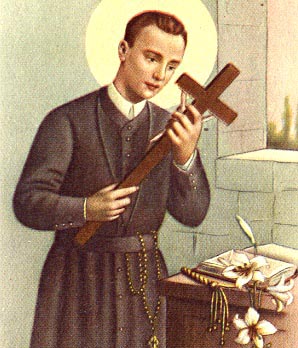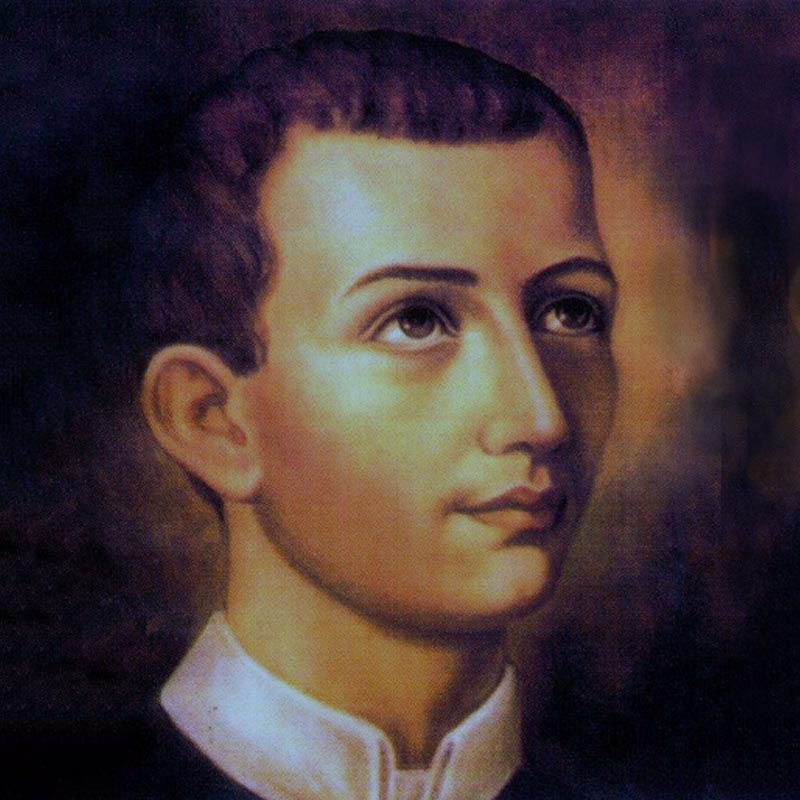St. Gerard: The Mother Saint

St. Gerard never set foot outside Italy, left no significant writings, and died at age twenty-nine after only six years of religious life. But even in his day, this humble Brother was considered a saint. He was friendly and generous by nature, and his confidence in God’s goodness seemed to give him supernatural influence. One biographer called him “the spoiled child of God” because whatever he asked for in prayer, he got.
After his death, one particular miracle attributed to his intercession increased his popularity. A woman who had known Gerard when she was a child faced life-threatening complications during labor. Suddenly, she cried out for a handkerchief that Gerard had given her years before. The handkerchief was fetched and placed over her womb; the woman’s condition improved immediately and she delivered a healthy baby. This was no small feat in an era when only one out of three pregnancies resulted in a live birth, and word of the miracle spread quickly. By the time of Gerard’s beatification, he was known throughout Italy as “il santo dei felice parti,” “the saint of happy childbirth.”
Today couples throughout the world turn to Saint Gerard when they are having difficulty conceiving a child, when a child is sick, or when a family member is in need. Heartrending letters of petition and thanksgiving still pour into the League of Saint Gerard, founded by the Redemptorists of the United States in the 1940s.
Who is this saint who inspires thousands to unburden their hearts?
Born on April 6, 1726, in Muro, Italy, Gerard was the fourth child and only son of a tailor named Domenico and his wife, Benedetta. He was a prayerful boy but was by no means solitary or sour. One biographer writes, he was immensely charming, had a great sense of fun, and loved to play practical jokes. Gerard’s first great sorrow was the early death of his father. Although Gerard was an exemplary student, Benedetta was forced to remove him from school at age twelve. For six years he worked long hours to help support his family, first as a tailor’s apprentice, then as the bishop’s houseboy. Twice in his teenage years Gerard applied to join a Capuchin monastery; twice he was rejected because the superior thought he looked too weak and sickly.
At age eighteen, Gerard opened his own tailor shop and seemed cheerfully resigned to his trade, until the day fifteen Redemptorists blew into town to give a mission. The fiery missionaries were members of a new religious institute founded by Alphonsus Liguori. Gerard was swept off his feet. He approached the superior, Father Cafaro, and asked permission to join. Father Cafaro took one look at Gerard’s bony body and pale face and dismissed him.
This time, though, nothing would deter Gerard. He hung around the missionaries all day and badgered Father Cafaro. On the last day of the mission, Father Cafaro advised Benedetta to lock Gerard in his room so he wouldn’t follow the Redemptorists out of town. Although Benedetta no longer depended on Gerard for financial support, she willingly complied. When she unlocked Gerard’s bedroom door the next morning, however, Gerard was gone. The window stood open and a knotted bedsheet hung from the sill. A note on the bed jubilantly proclaimed, “Have gone to become a saint!”
Gerard caught up with the missionaries about twelve miles outside Muro. When his pleas failed to move Father Cafaro, Gerard tried a new tactic. “If you do not receive me,” he said sweetly, “you will see me every day begging alms at the monastery gate.” Father Cafaro gave up and angrily scribbled a note of introduction to the Redemptorist novice master: “I am sending you a useless lay Brother.”
The novice master doubted that the skinny new postulant would last a month, but Gerard was beside himself with joy, and that joy was a terrific source of energy. He threw himself into even menial tasks, “sweeping, scrubbing, and sewing his way to heaven.” In his brief religious life, he served the community as tailor, gardener, infirmarian, sacristan, carpenter, baker (not a very good one, we’re told), and porter.
At heart, though, the hardworking Brother was a mystic. “If God were to remove this veil from our eyes,” he once said, “we would see paradise everywhere; God is here, even beneath these rocks.” He spent hours before the Blessed Sacrament, and his deep union with God was evident through frequent ecstasies and the gift of healing. Gerard’s prayers brought about the cure of a teenager dying of tuberculosis, the multiplication of food for the poor, and the healing of a paraplegic girl. He was a skilled guide for people burdened by depression or wavering in their faith since he, too, battled depression and doubts about his faith.
In his free time, Gerard liked to visit the sick. Public hospitals were filthy, wretched places in the early eighteenth century. Gerard brought candy to the patients, did what he could to make them comfortable, and – perhaps most importantly – spent time chatting with them. At the end of one of his visits, the patients were so upset when he rose to leave that they pinned him to a chair. The hospital staff had to pry Gerard out of the patients’ arms.
Not everyone recognized Gerard’s gifts, though. When Gerard’s superior asked him to give a conference on Saint John’s Gospel to a group of seminarians, the students grumbled. What could a Brother with only a primary school education teach them? But once Gerard began, they were captivated. A theologian who heard Gerard speak later wrote, “Learned men are silent before this poor unlettered Brother. He draws knowledge from its source, the heart of Christ, not from the muddy cisterns of the human mind. In his mouth the most obscure mysteries become luminously clear.”
In 1753, Gerard became the subject of a malicious rumor. An acquaintance named Neria accused Gerard of having had relations with a young woman. When Alphonsus Liguori received a letter informing him of the allegation against Gerard, he promptly summoned him. Gerard had never before met the Redemptorist superior and perhaps anticipated a warm reception. We can only imagine his confusion and embarrassment as Father Liguori read aloud the incriminating letter.
When he had finished, Father Liguori looked up and waited for an explanation. Gerard remained silent. Father Liguori was bewildered. Although he doubted that this highly regarded Redemptorist was guilty, he was forced to take the allegation seriously and prohibited Gerard from having any contact with the outside world. Gerard was in disgrace. His confreres urged him to clear his name. “It is in God’s hands,” Gerard answered. “If he wills that my innocence be proven, who can accomplish it more easily than he?” Fortunately, a few months later Neria’s conscience began to torment her. She admitted that she had lied, and Gerard’s name was cleared.
By the spring of 1755, Gerard’s health was failing. Tuberculosis left him looking “more like a ghost than a man.” A few months before his death, he wrote in a letter to a friend, “The pain is so very, very severe that I cannot follow in Christ’s footsteps, I cannot walk, I cannot even move, being fastened with him to the cross, and in terrible agony. Everyone seems to have abandoned me. I bow my head and say, ‘This is the wish of my dear Lord. I accept it.’”
One of Gerard’s last requests was that a sign be tacked to his door, saying, “Here the will of God is done, as God wills, and as long as God wills.” He died just before dawn on October 16, after crying out from his bed, “Look! Look! It is the Madonna.”
Events in the Life of Saint Gerard
1726: Born April 6, in Muro Lucano, Italy.
1731: Miracle of Infant Jesus giving him bread.
1738: Father died, worked for tailor.
1745: Became a tailor with his own business.
1747: Resolved to be completely like Christ in his life.
1749: Joined the Redemptorists.
1752: July 16, First Profession of vows as a Redemptorist.
1754: Endured false accusations.
1755: Died October 15.
1893: Beatified by Pope Leo XIII.
1904: Canonized by Pope Pius X on December 11.
________________
This story first appeared in the October 2009 issue of Liguorian Magazine.
St. Gerard Novena Book Available Online!
Prayer to St. Gerard
Dear St. Gerard, on this day in 1755
you gave your entire life back to God,
ultimately and completely.
Today we celebrate
your total victory over sin and death,
and your definitive entry into the Kingdom
where God’s Love reigns forever.
We celebrate your feast,
honoring your passage through death
to the fullness of life in Christ.
We celebrate God’s holiness dwelling actively within you,
transforming you into one of God’s many saints.
We ask your blessing upon
and prayerful intercession
for all women who are already mothers
and for all pregnant women,
especially those with high risk pregnancies
or facing difficult deliveries;
and for all women who long to be mothers,
but are finding it difficult to conceive.
May they be blessed with the fruit of the womb.
May all mothers raise their children to seek,
know, love and serve God and so
become holy saints like Saint Gerard.
Dear St. Gerard, faithful friend,
obtain for of all mothers the grace
to persevere in living their vocation
and completing their motherly mission,
with loving arms and hearts,
patient love and compassion,
quiet, peace-filled joy and undying hope.
Through Christ, our Lord.
Amen.

